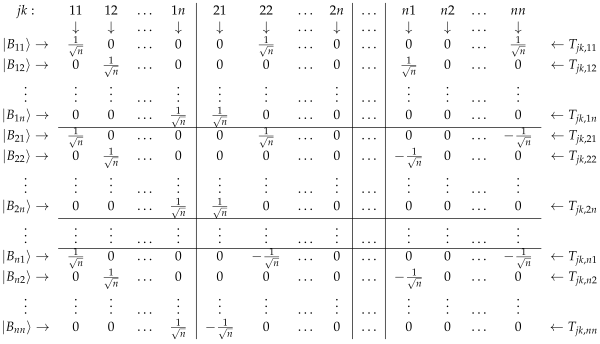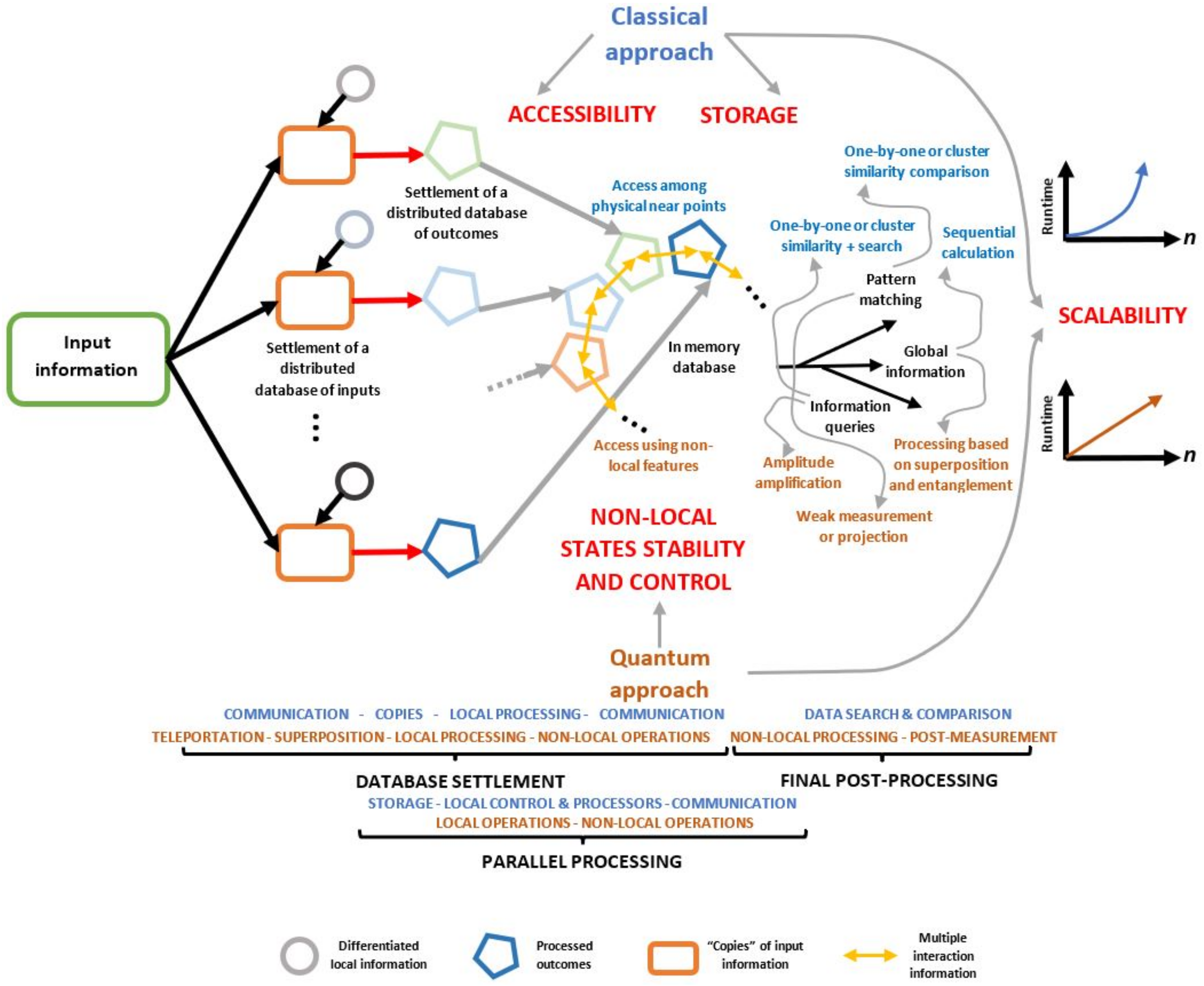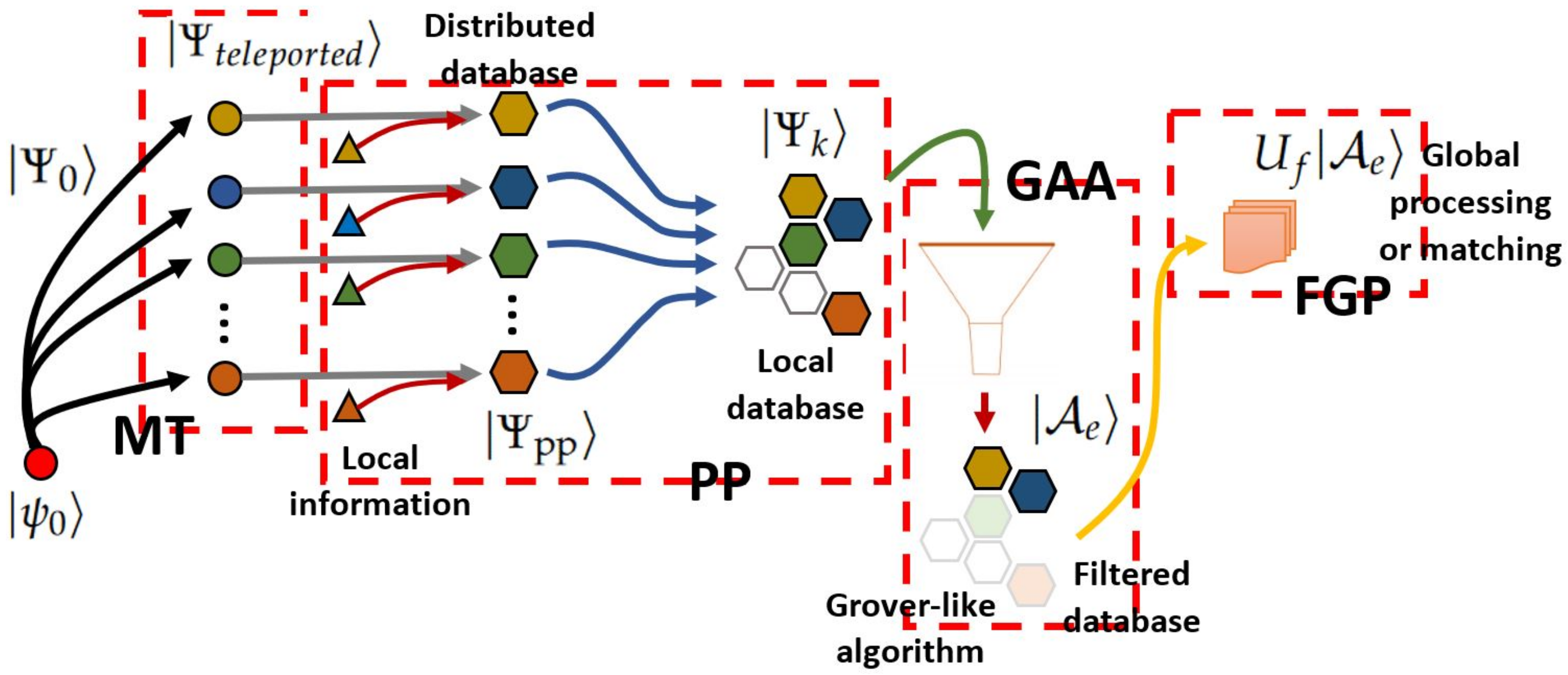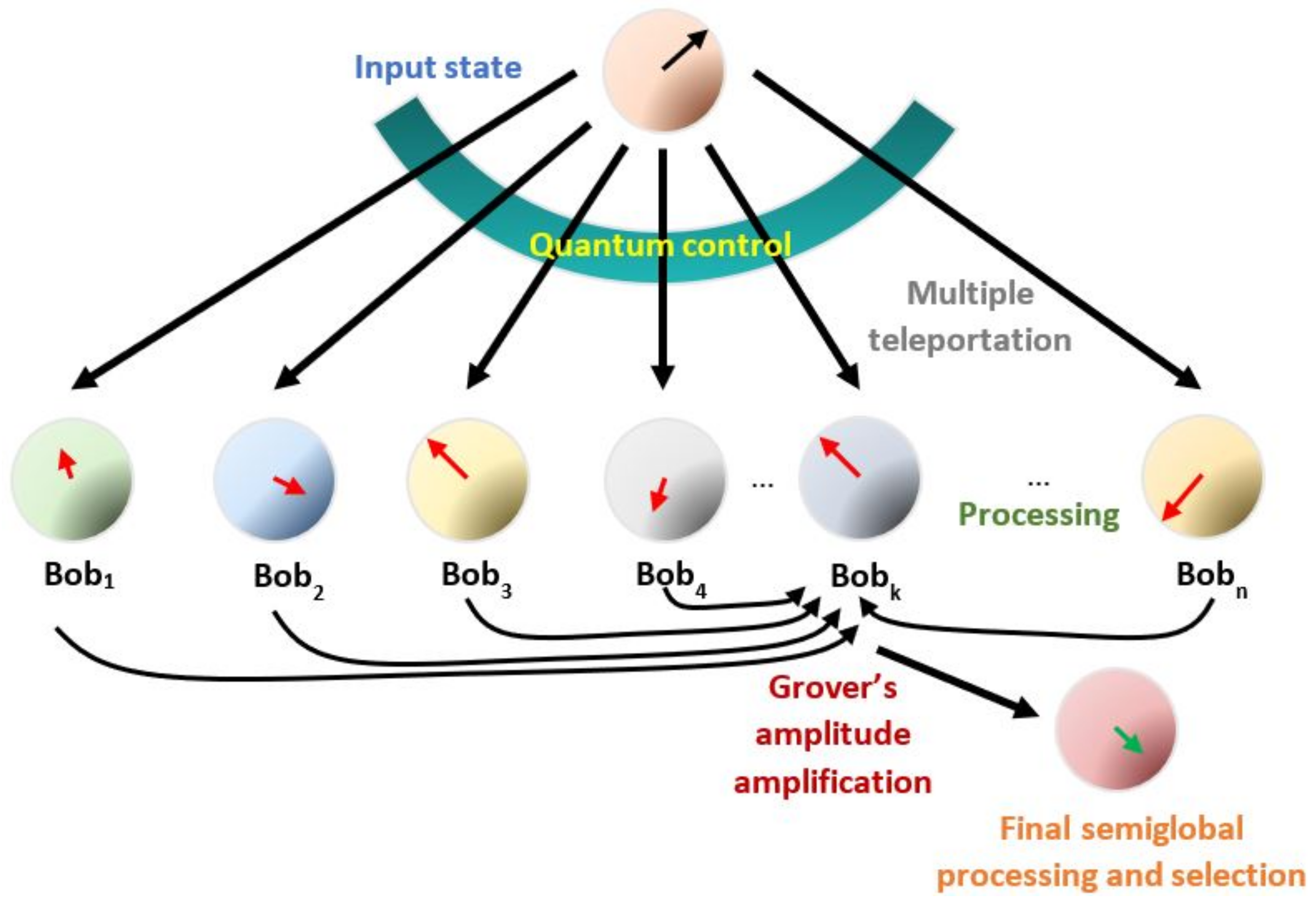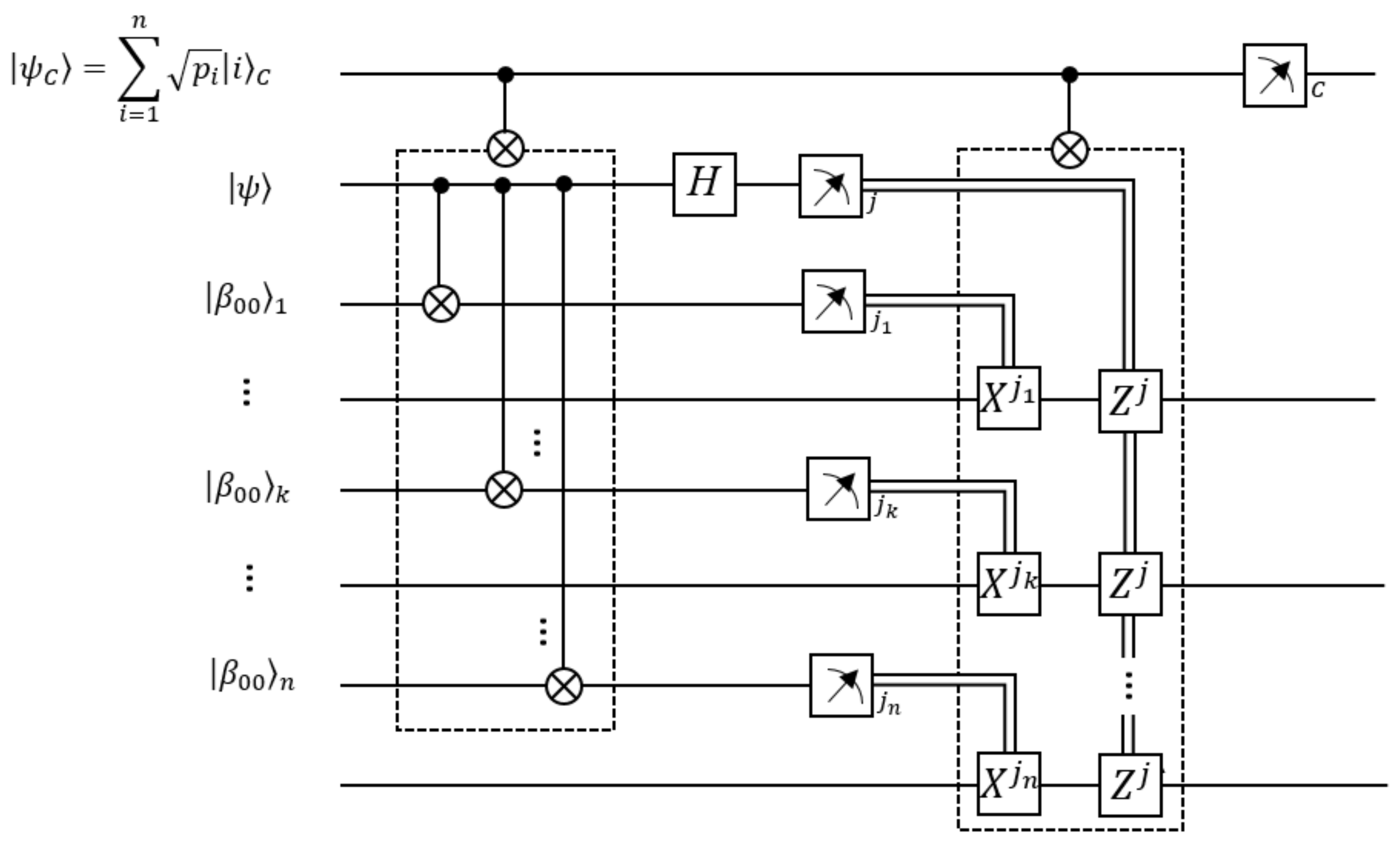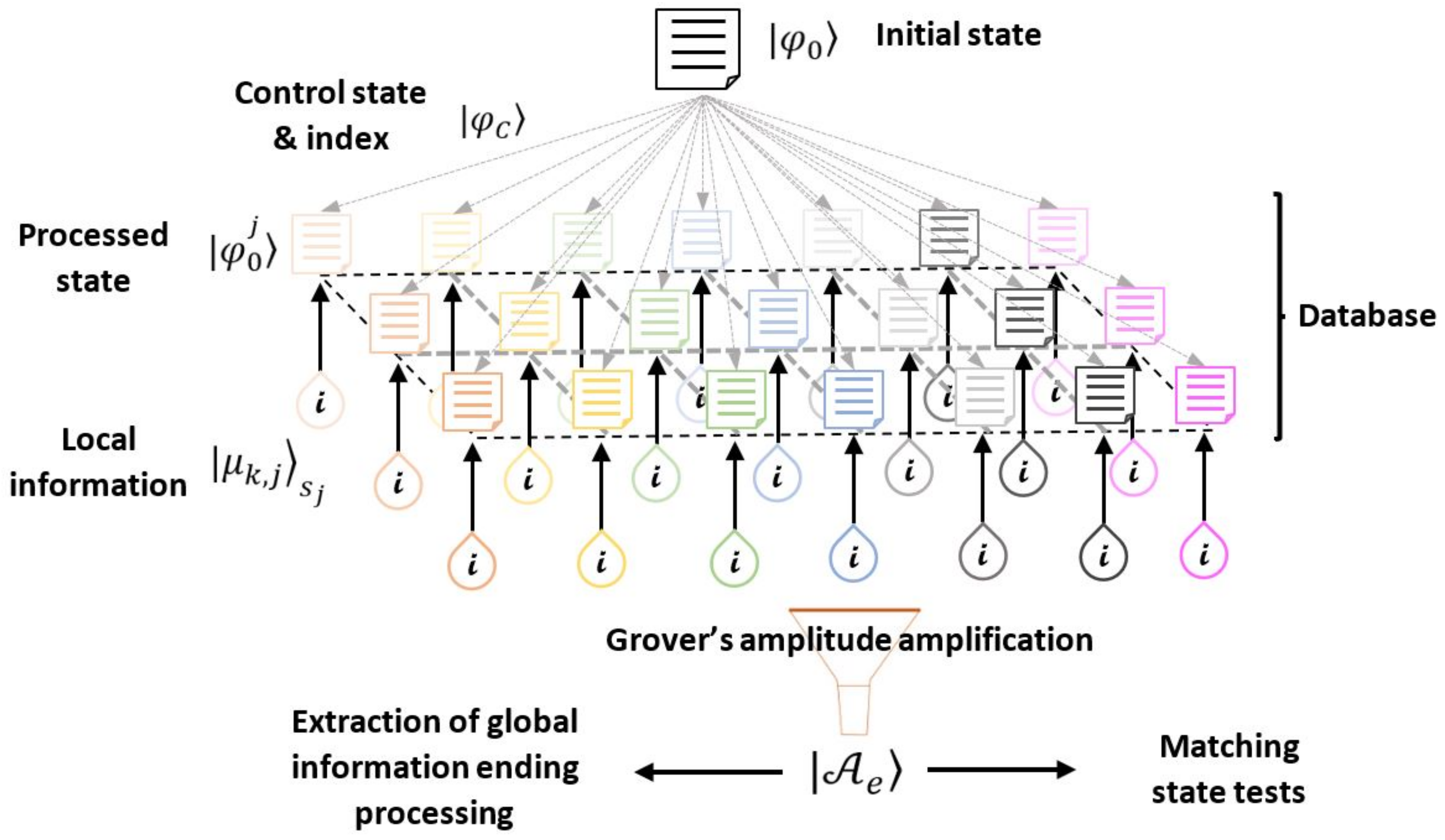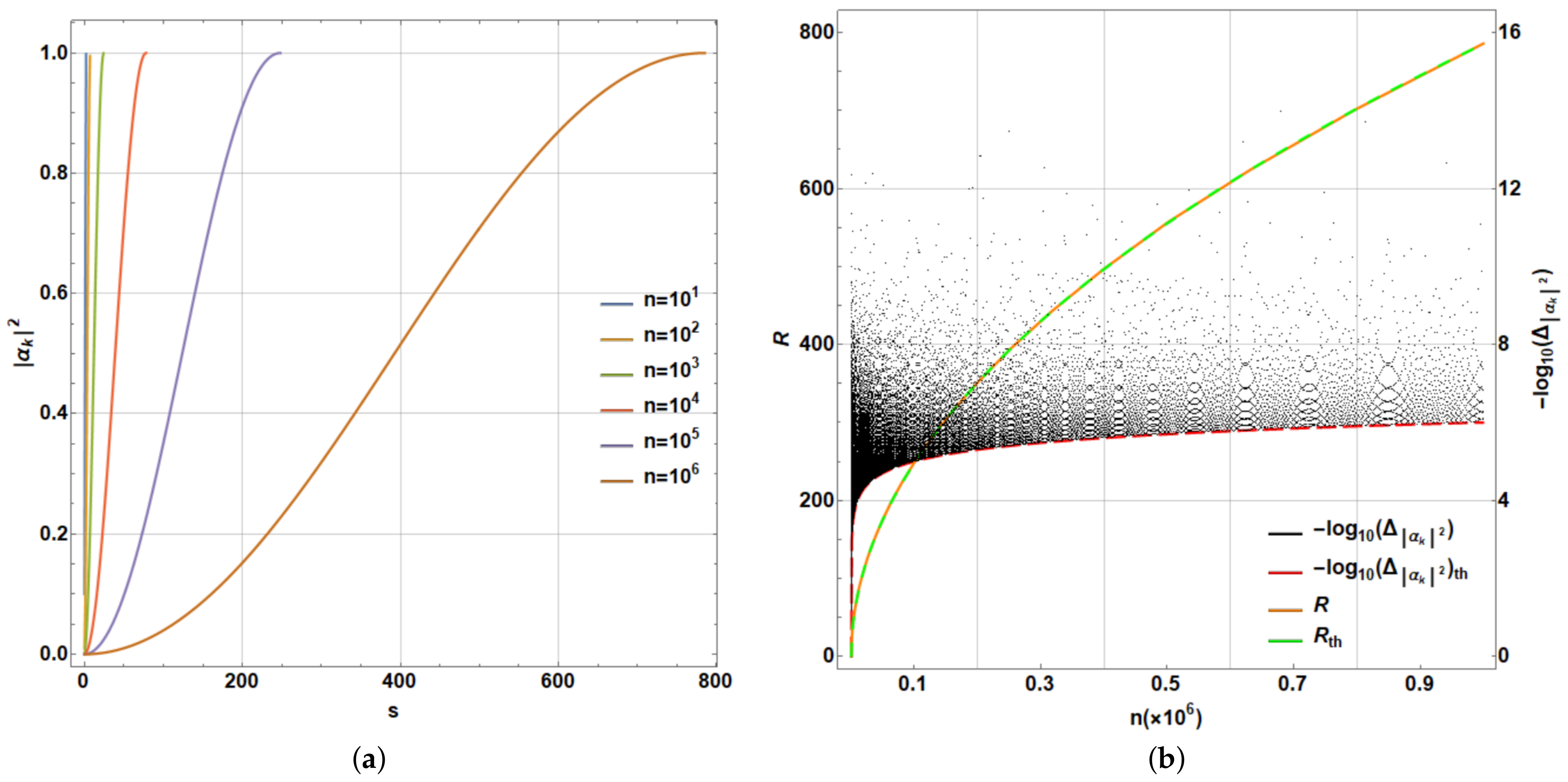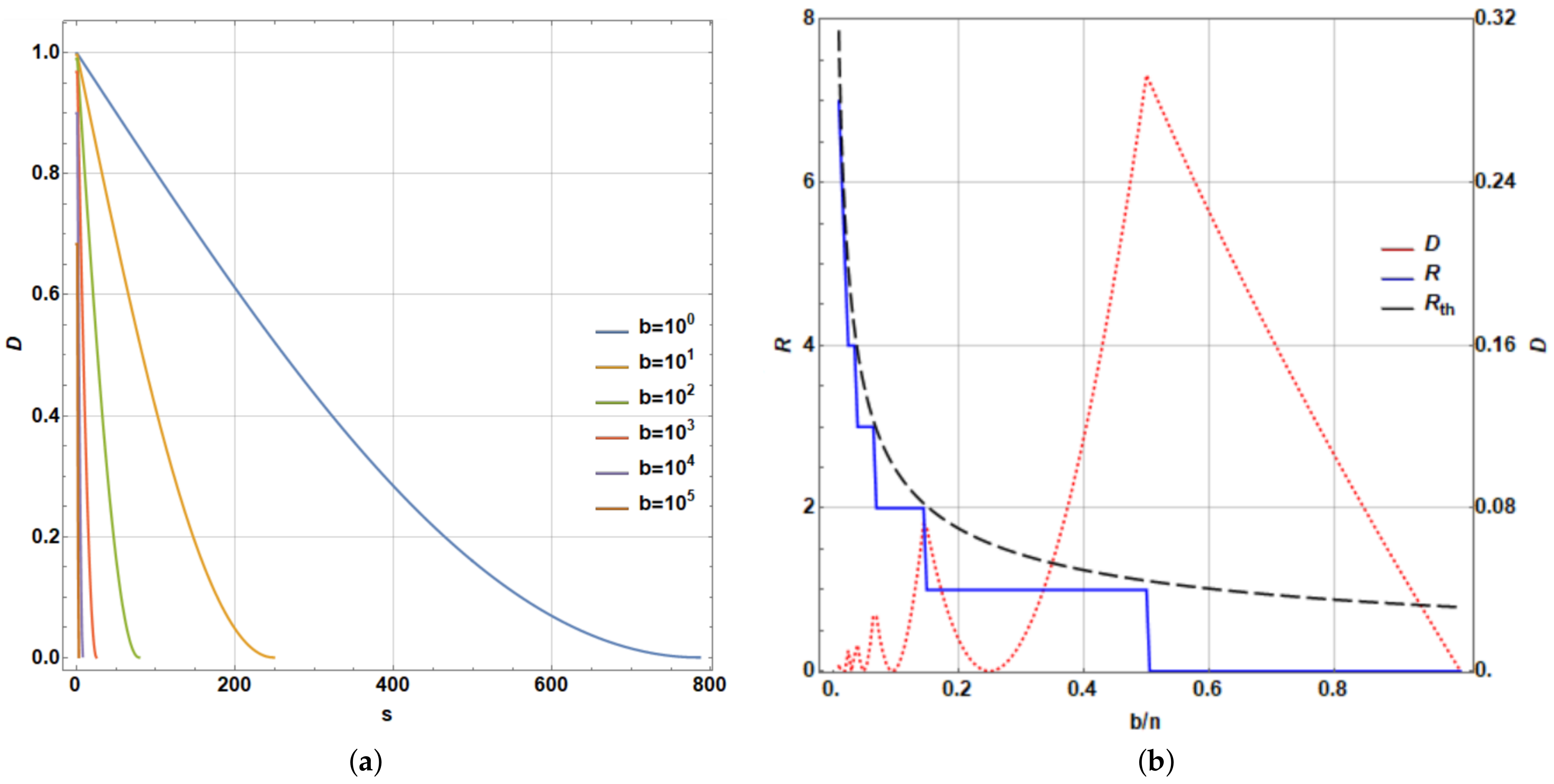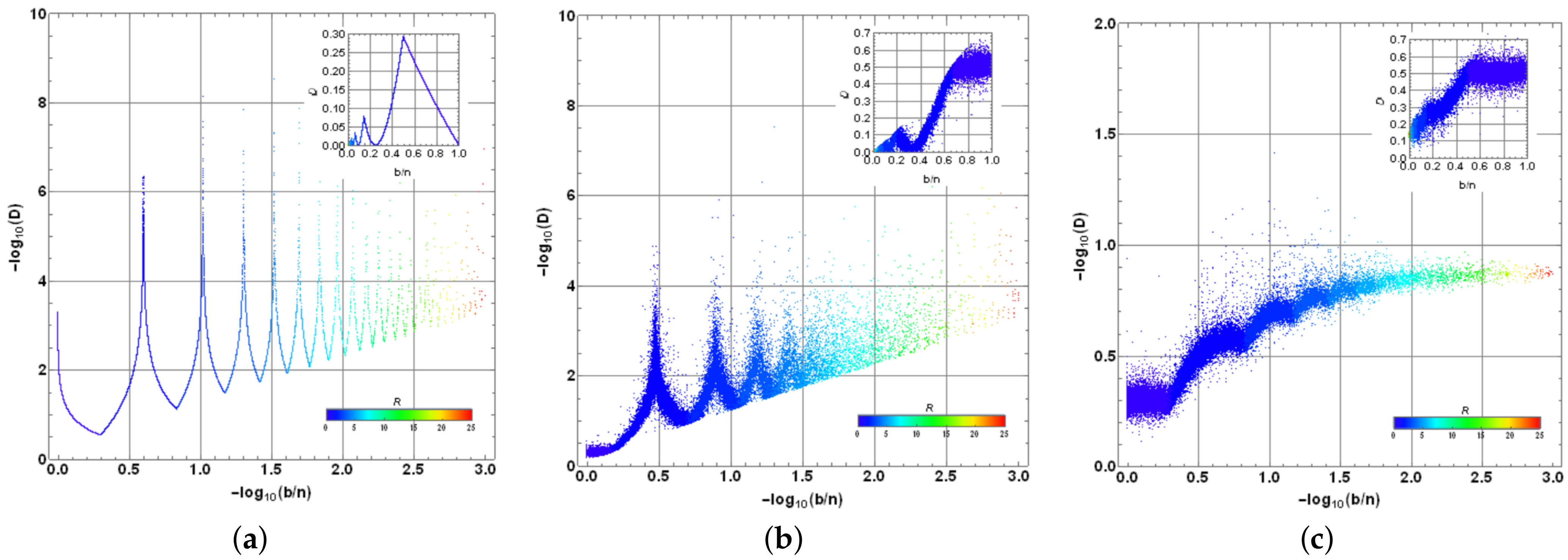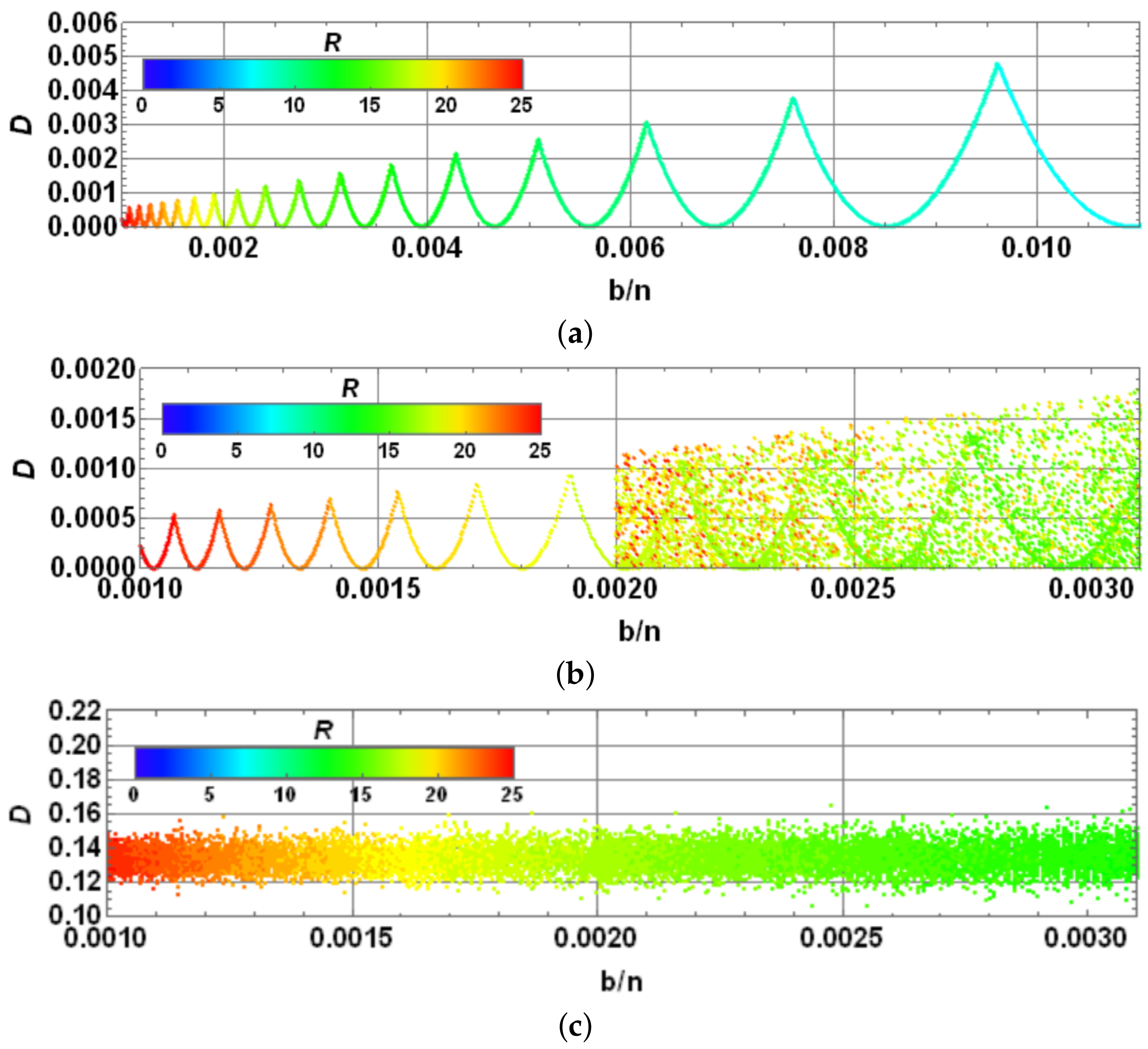1. Introduction
Despite light being used to prove many features in quantum information and quantum processing, the use of matter will open a vast terrain for growing quantum applications. The current quantum processors use a limited number of systems as qubits; however, a small amount of matter, when controlled, can dramatically increase the quantum storage of information. There, quantum elements are near arranged; thus, non-local features can provide novel ways of processing, which is currently being performed by quantum communication.
An increasing number of knowledge areas and disciplines consider interactions with quantum information, communication, and processing to solve complex simulation problems, to obtain improved security or reproduce processes of machine learning or artificial intelligence. Recently, the term quantum cognition (QC) was coined to focus on the brain function quantum phenomena through disruptive research [
1,
2]. Such an area deals with the processes of perception, apprehension, comprehension, cognition, and decision making, particularly regarding quantum mechanics associated with the human brain [
3]. Quantum logic is settled by the properties of quantum operators mainly representing observables, which become conjugate variables and subsequently Pontryagin duals [
4], as is clearly illustrated by the Dirac three polarizers experiment [
5]. Furthermore, the quantum Zeno’s effect [
6,
7] exhibiting superposition states and quantum entanglement for composed systems are considered, both of which feature quantum mechanics.
Traditional computing approaches are centered on sequential processing based on the Turing machine, still based on parallel processing (used as a procedure for acceleration). For instance, machine learning procedures still follow a linear procedure of composed steps that considers layers that, in the best case, probably considers parallelism or recursion [
8,
9]. Such approaches have reached quantum computation despite the fact that they only mildly exploit superposition and entanglement. While cognitive brain function is traditionally believed to be based on Bayesian inference through the free energy minimization principle, it still appears in conflict with QC owing to removal of the redundant search space, thereby moving toward non-optimal decision making. In fact, when the brain learns certain information, it can still infer contextual information to reach a desired outcome under a different situation, which considers different information from that initially and concretely owned. This implies, in parallel processing, a large amount of alternatives is selected until a final decision is made [
2].
Nevertheless, new quantum computation models [
10,
11,
12] have emerged after the circuit model based on universal gates, which is widely used. Following the trend, recently, a new paradigm of quantum computing-denominated quantum intelligence (QC) [
13], which considers QC as a wider usage of quantum features in the brain function, has been proposed. In this approach, Bayesian inference is not applied in excess, leading to the inclusion of complementary events with non-zero probability, as in the classical version where events commonly outside the problem context are considered with zero probability. Such a difference allows for a wider context in the process of cognition that is closer to the real observed brain function closer to fuzzy systems [
13,
14].
The last fact suggests that wide-spreading knowledge boosts the simultaneous generation of processed alternatives to be selected later. With regard to quantum theory, this suggests that a large superposition of outcomes still maintain correlated links upon their selection. Thus, the settlement of a large database of processed outcomes departing from a single limited information diversified through processing operations (along with integration of concrete local information) should be considered as an elementary quantum process for reaching a global outcome or matching certain external information.
In quantum processing, such a database implies establishing differentiated information suitably codified on a set of quantum states. When the last operations are barely independent, parallel processing should be conveniently introduced owing to the number of tasks. Parallel processing has been pursued as a solution to certain complex problems based on our current computer technology. Such processing can be understood in the context of either classical or quantum systems. In classical systems, we can reduce the time required to solve a task by using certain information processing units simultaneously, whereas in the quantum realm, all of the input information can be addressed and combined into a single register, where such a quantum unit can still process all of them in only one step [
15]. Thus, quantum computing has been hailed as an efficient massively parallel computing scheme [
16].
The parallelism in quantum computing essentially relies on the ability of a physical system to exist in a superposition of states, thus allowing for a massively parallel solution of specific problems that are not efficiently handled by a classical computer, such as integer factorization performed based on quantum theory using the Shor algorithm [
17]. Otherwise, the settlement of large quantum databases is particularly useful in quantum image processing (QIMP) and, in general, in quantum pattern matching (QPM) [
18,
19]. Considered as the foundation of quantum computation and quantum communication, teleportation is a process of quantum information transfer in the form of a quantum state from a system into another [
20,
21] and not limited to larger system states [
22]. Teleportation becomes a useful quantum tool to send information on faraway receivers; moreover, alternatives for close systems in matter conglomerates are available. In addition, controlling such algorithm is feasible to selectively send information to several parties under superposition [
23]. Such information transference can be exploited to set a large and diversified number of parallel processing operations using the same input. The outcomes can be stored in a temporary database through superposition.
Classical decision making regards the selection of information through Bayesian inference; however, quantum mechanics still provides privileged access to parts of classified information under dynamical processes where all such parts can play a role until a tentative measurement is acquired. Thus, in terms of quantum processing, such a selection of information can be performed through measurement or amplitude amplification, as exemplified by the Grover algorithm [
24]. Such selection is useful for either performing a final global processing, extracting global information, or matching external information. Suitable and specific algorithms to codify, combine, and extract such global information incoming from the database outcomes can be implemented using only few steps owing to the state superposition and entanglement remaining in the global system. Such processes appear nearer to those considered by QC and QI.
The aim of the current study is to explore and analyze a multi-step quantum model to establish a database of outcomes obtained by chaining teleportation and subsequently parallel processing. The dataset settlement and further parallel processing on a local memory are classically and commonly waived. Based on alternative quantum approaches for both problems, we present a non-local approach exploiting the main features of Quantum Mechanics. Thus, the proposal is strongly based on non-local features provided by quantum systems. Such a process improves the classical issues present in classical database settlement in terms of communication, as discussed in the next section. This processing departs from a codified single qubit state as input, transferred in superposition on several systems working as processors via multiple quantum teleportation. The set of superposed outcomes fits the concept of a quantum database. Subsequently, a subset of them can be accessed through amplitude amplification. Finally, such a subset can be used for acquiring the stored global information or for information matching or query tasks. The process fits the feasible quantum artificial sensing and decision-making tasks, and it is also applied to explore a possible cellular process in QC and QI. The second section deals with the technical statement of the problem regarding classical concepts and issues around databases, parallel processing, and pattern matching. After discussing their possible advantages, the quantum versions are elaborated. This section also presents the global plot being presented along with the variables considered in the development. The third section presents the details of multiple teleportation and post-processing, thus setting the distributed database of outcomes. Furthermore, we discuss certain non-local procedures via entanglement to move the entire set of processing outcomes into one single party and continue with other possible ending procedures. Such important aspects consider teleportation processes for short or large distances (matter conglomerates or artificial processing systems). The third section discusses the post-selection process comprising stochastic post-selection and the subsequent analysis regarding the adaptation of Grover’s amplitude amplification algorithm to the last database outcomes in terms of recursive expressions, error quantification, and convergence under certain post-selection scenarios. The fourth section discusses several aspects related to the associated and translated errors from the previous amplitude amplification procedure on tentative further ending global processing or pattern matching. Certain aspects related to quantum circuit implementation are discussed, along with possible applications. The last section discusses the conclusions and future work.
2. Classical and Quantum Approaches for Parallel Processing on a Database Settlement
In this section, we set the classical concepts of database and parallel computing, discussing their possible issues in terms of future development, particularly those due to scalability in terms of the complexity of computing problems. Thereafter, quantum versions are discussed to introduce the current proposal.
2.1. The Classical Concepts of Database and Parallel Processing: Issues and Challenges
In classical computing, a database is a stored collection of data suitably organized to be electronically accessed, where organization for data access is realized through a register or index for each ordered set of data [
25]. While databases have continuously grown, they are currently stored in computer clusters instead of simple data files; nonetheless, they are managed by software, a specialized database management system (DBMS). Data can be structured or otherwise ordered as a string; however, in any case, an explicit or implicit index is required. Databases could be stored
on-disk, i.e., they may be enduring or permanent on a physical device. Otherwise, databases
in-memory are a type of temporal set of data residing in the main memory of the processing device and can be accessed faster than the ones stored on disks.
Encoded in bits, a large number of data are settled temporarily on the main memory. Specialized software and algorithms attempt to optimize the access, processing, and queries on large databases. However, there are limits mainly pertaining to the physical media where data are stored: different places on the same device require specific logistics. Thus, their scalability with an increase in the database volume and their speedy access to information when multiple sets of data should be searched and used, naturally become contemporary challenges for classical databases in applications related to Data Science, particularly in genomics [
26], which has stated new size limits.
In another trend, parallel processing or parallel computing is an approach in classical computation, where many of the involved computations in computer processes are performed simultaneously because they are commonly independent. Accordingly, the outcomes can be combined afterwards [
27]. Despite the first approach of computation being serial computation, parallel processing is in fact a natural function in the brain. In fact, currently, the brain is considered a massively parallel computer [
28]; thus in Psychology, the term parallel processing refers to the ability of the brain to simultaneously process several stimuli obtained through the senses [
29]. Thus, parallel processing is in fact believed to be a natural way of processing in the brain. For this reason, the model presented could also mimic the brain behavior, upon elucidation of certain possible quantum features. In fact, because teleportation is a key element in the procedure to set a distributed database, it can be induced over short distances, not for telecommunication processes, rather for communication among chemical or still biological subsystems. In fact, as a consequence of entanglement, such effects are widely known in certain biological processes, such as bacteria, sensing optimized paths for energy transfer [
30].
With the design of computers integrating more than one processor (the basic unit using incoming information to perform transformation on it by applying a defined computing procedure and possibly integrating additional information), parallel computing has become a more common approach to classical computation models involving
-movement in real time or simply any complex computation problem requiring improved polynomial runtimes at par with its scalability. Nevertheless, the speed-up introduced by parallelization is expected to be linear, and not all problems are completely parallelizable, bounding such linear behavior. In fact, it limits the performance in agreement with Amdahl’s law [
31] stating the potential speed-up of an algorithm upon parallelization. The last limit is mainly associated with the impossibility to completely parallelize any problem; however, it also considers other factors referred to as access of information imposed on parallel processing.
2.2. Statement of the Current Database Settlement Problem in the Classical Approach
In a classical parallel computer, the main memory used to perform calculations is either a shared memory (among the processing elements located on a single storage space) or a distributed memory (where each processing data cluster has its own storage space). As expected, access to local memories is commonly faster than access to non-local memories [
32]. Because all types of accesses are present in a typical parallelizable problem, physical or logical distribution imposes a natural slow down on scalability, doing speed communication the bottleneck of the process [
32], either in the information access or in the necessary communication among computer parts during parallel processing.
Thus, in this work, we analyze a multi-step approach for parallel processing, which naturally demands the settlement of a database in a temporary memory. In the classical approach, the settlement, either regarding communication from permanent sources or information or simply the copying process of the main memory, to initialize parallel computing requires a sequential task based on use of a unique integrated control system. In the quantum approach, superposition improves such limitation. Copying, still limited by the no-cloning theorem, can be solved by multiple teleportation as a notable aspect, generating processable copies of a state in superposition to acquire from the outcomes an output with global information obtained by departing from the outcomes, before any measurement performed on the system.
2.3. Quantum Parallelism: Quantum Alternatives for Storage and Processing Systems
For scalability, storage and data access require an increasing additional runtime consumption owing to the limitations imposed by physical systems used in classical computing. Thus, database and parallel processing become related concepts integrating processing units which read data locally or non-locally to be involved repeatedly on specific computing tasks.
Alternative to classical databases, quantum databases refers to the use of quantum systems to store information. It is believed to solve limitations imposed by classical approaches due to superposition of physical states used as information containers. Superposition addresses both volume and access time [
33]. In the quantum model being presented, we are considering an in-memory database, being temporal for a concrete and an ephemeral purpose involving processing, query, and post-processing.
For parallel processing, an alternative approach, quantum parallelism enables performing extensive calculations in parallel via superposition, thus stating a natural key advantage over classical computing in terms of the time and storage space. In addition, quantum systems still provide additional features boosting the possibility to introduce controlled non-local operations performed remotely through the quantum feature of entanglement [
34]. In the current unit processing being analyzed, we exploit both quantum features, superposition, and entanglement, integrating the settlement of a distributed database combined with further differentiated processing to finally perform a query or acquire global information. That the model reproduces or suggests possible cognition tasks present in the brain proposed by disruptive models [
13] suggests that the brain is a system possibly exhibiting quantum features in its macroscopic functioning.
Figure 1 shows a diagram summarizing the interactions between database settlement and specialized parallel processing. Departing from possible input information, several independent computing processes obtain differentiated derived results as output. Extensive problems fit such a process. For instance, the generation of alternative prototypes solves certain technological necessities, the determination of an optimized distribution path in logistics, or the decision making for the brain realizes how driving certain objects as the first experience departs from its perceived form and size. All those problems require diversified, prospective, and alternative views or solutions to be matched with a certain specific outcome or otherwise to obtain an integrated outcome comprising all individual solutions. Thus,
Figure 1 compares the classical (blue) with the quantum (brown) approaches to both problems and their integration. Critical aspects highlighted in red for each approach are important functions of the scalability of concrete computing. Classical physical computing devices devote specific spaces to set each part of information. Thus, it requests storage along with speedy accessibility limited by distances and the growing number of interconnections among those parts, still considering an in-memory database processing [
33].
Nonetheless, a quantum approach requires a tight control over the stability of quantum resources, particularly those exhibiting non-local properties. However, such limitations are superseded with the increasing development of quantum technologies, whereas classical systems exhibit strict final physical limitations owing to their nature. The settlement of information on classical devices requires centralized control to manage the storage increasing runtime upon scalability. It implies normally an exponential growth in the runtime for classical processing approaches, whereas in the quantum case, the growth is linear or polynomial. The same is true during parallel processing that still considers distributed processors with independent management systems. Quantum systems are less dependent on the storage space, not only due to the nature of systems employed, but also because they exhibit compact coding along with a natural processing speed up mainly due to superposition [
34].
2.4. A Quantum Model for Database Distribution and Settlement
In the current development, a quantum database settlement (the initial multipartite storage of detonating information) will be developed by first teleporting a single qubit state (as instance, but easily generalized for bigger information states) on a set of potential receivers or processors via controlled multiple teleportation. Subsequently, such a set of processors will state a distributed database with an index naturally introduced by the control state previously used. Those processors can then introduce additional local information. Processors activate quantum parallelism by performing a series of differentiated processing tasks boosted by the original qubit. Accordingly, a partial selection of outcomes works as a filter. At the end, final global processing or matching tasks can be performed to extract or gain certain global information or otherwise to perform a pattern matching operation.
In this study, the aforementioned procedure undergoes several structured steps: Multiple Teleportation (MT) and Post-processing (PP) developed in
Section 3. In
Section 4, the Grover’s Amplitude Amplification (GAA) for the current analysis is presented and analyzed. Finally,
Section 5 presents suggestions and analysis for a Final Global Processing (FGP) or Pattern Matching (PM).
Table 1 comprises several states, operators, and related quantities used in each main step mentioned. In addition,
Figure 2 provides a previous summarized view of the entire process in terms of those elements.
3. Multiple Quantum State Distribution Model for the Database Settlement Based on Teleportation
The settlement of database is commonly supposed to be loaded or stated in many developments of quantum processing, pattern matching, or query problems. Reality is far different because setting ordered information on certain physical storage requires precise read and write operations [
35]. Despite the complexity of managing non-local resources or efficient methods to perform teleportation, it can be a straightforward process for such a settlement, which nevertheless requires preparation to set entangled pairs in suitable locations. Current technological developments are successful, such a problem based on entanglement distribution. For instance, satellite-based entanglement distribution [
36] ranges such delivery around 1200 km. Otherwise, state teleportation can naturally occur over short distances as molecular or biochemical structures at nanoscales [
37,
38].
Multiple teleportation process enables transmitting an arbitrary and possibly unknown quantum state. Particularly, double teleportation has been already exploited for cryptography purposes in the settlement of secure authentication [
23] and in Quantum Key Distribution (QKD) [
39]. Nonetheless, the double teleportation process has exhibited non-locality activation in the quantum state transference [
40]. As an extension, in multiple teleportation, a state is quantumly transmitted in superposition to several receivers supported by other quantum states used as a control. Such receivers perform differentiated local processing operations stating a distributed database in superposition, but still identified by an index being introduced by the control state. The database is finally collected on one of those receivers.
By introducing the traditional characters of communication in the procedure, the original qubit whose state is teleported is originally in possession of Alice (the initial producer of detonating information), who has previously distributed a set of shared entangled resources on the receivers (which is called Bob’s; each one is the main part of each distributed processor), as in the traditional teleportation algorithm. Furthermore, the control state assists the process (it can also be in possession of Alice or another party) to possibly “decide” the final teleported state (i.e., superposition). In our approach, the original qubit is transferred to one specific party, and we independently process each distributed state to generate diversified information, possibly introducing additional local information: a distributed database. Finally, such outcomes are transferred on one party setting a local database in superposition to post-selecting a subset for further purposes. The process is depicted on
Figure 3. Thus, the entire process beginning with multiple teleportation undergoes several processing layers:
.
3.1. Multiple Quantum Teleportation Procedure and Their Local and Non-Local Control: Dataset Settlement and Parallel Processing
The current process of teleportation (MT) begins with Alice attempting to teleport the state confined on a qubit labelled as 0:
. In fact, our process can be easily generalized to teleport larger quantum states
, at least those obtained as a combination of
p two-level systems with dimension
[
22]. It does not require deeper changes (particularly after the teleportation) than introducing additional entangled resources. We consider this simpler case to develop our procedure. The qubit is pretended to be potentially teleported on a group of
n receivers called Bob
, Bob
, …, Bob
. For this task, she prepares a group of Bell entangled resources
, on qubits
. In addition, she shares one qubit of such resources sequentially, with each Bob
. In addition, someone prepares a control qubit with
levels. Otherwise, it can be prepared using a set of
q qubits to compose a state of dimension
, as discussed later. Thus:
then, the beginning total state to be considered can be expressed as:
We consider an easier case as an illustrative approach using a two-level system as a detonating state. All our development can be extended by considering
as a larger state than a qubit, or otherwise a composed state of two-level systems. In any case, it can also be teleported in the worst case, system by system, using the traditional teleportation algorithm with additional entangled resources [
21,
22], or more efficient algorithms using larger systems [
41]. For the current approach,
Figure 4 shows the entire quantum circuit of the process. Alice (or someone else including the management of the control state and the Alice state) prepares the following controlled gate to process her qubits, with the teleported qubit as control in this step:
here,
denotes the application of gate
U on the qubit
b controlled by the qubit
a:
. The nature of this non-local gate and other included in the development will be discussed below. In fact, such a gate can be understood as a series of Toffoli-like gates
:
Clearly, such a gate is unitary if we reduce it by pairs:
, where
is the identity in the subspace of the whole Bell entangled resources plus the input state. Thus, applying that gate, she obtains:
there,
is the
gate applied to the qubit
inherited from
(in general,
and
are the Pauli operators). By noting that
and:
there,
. Additionally,
odd and
even refer to a set of qubits with labels odd or even, respectively, conforming two composed
partite qubits
and
labelled with the
base number
s whose
base digits set the states of qubits conforming them. Thus, upon the application of
, the expansion provides all possible combinations of 0’s and 1’s for each qubit labelled with odd and even numbers by separate, but paired, with exception for the qubit
i in the second term owing to the
gate. Thus, the global state becomes:
In such an expression,
is the
i-th digit in
s when it is expressed in 2-base. Accordingly, Alice follows the teleportation process by applying a Hadamard gate on the qubit 0, thus obtaining the following:
After, Alice performs a measurement of qubits
obtaining the outcomes
, respectively (last outcomes corresponds to the
base representation of the
base number
s). Thus, the post-measurement state becomes:
where
refers to the entire
even qubits in the state
except by the
qubit. Alice uses classical communication to share the outcomes with each Bob
. Thus, they apply the following controlled operations on their qubits (see
Figure 4):
which means they take the input of measurements, but they are controlled by system
C. Such correction transforms 1’s into 0’s for all qubits, with exception of qubit
i (in each term of the sum):
where
refers to the entire
even qubits in the state
, with exception of
. Note that, independently to the outcomes in the measurements, we arrive to the state:
for the control and the even qubits by disregarding the remaining qubits. Finally, if the control qubit is measured with the outcome
(which has probability
), the information of the original qubit 0 is teleported to Bob
. The quantum circuit corresponding to the entire process has been graphically represented in
Figure 4. This includes an alternative ending, post measurement of the control state, which will be discussed below.
3.2. Multiple Semi-Local Parallel Processing to State a Local Database of Outcomes and Their Coherent Gathering: In-Memory Post-Processing
Notably, Bob knows who is in possession of the teleported qubit. Nonetheless, Alice cannot be sure of who will receive the teleported qubit; regardless, she initially prepares the control state to favor one or several selected qubits of Bob (if she has the control qubit). Formula (
12) implies that as a quantum superposition, the information on qubit 0 has been potentially teleported to Bob. Moreover, as illustrated in
Figure 3, quantum parallelism is activated by Bob by performing a different controlled quantum processing
on the qubit
based on the control state, considering
as input:
This step sets the parallel processing (PP). Accordingly, if
is the output of each processing
. Thus, we obtain:
which potentially comprises all outcomes of the set of processing
. Concretely, it sets the distributed database being indexed by
. Additionally, all such outcomes can be transferred to Bob (see
Figure 3), namely Bob
, by means of a controlled
gate (
gate exchanges the states between qubits
a and
b as
) in the form:
thus obtaining the following state separated from the remaining Bobs (omitting the tensor product symbols for simplicity):
with
. Although Alice cannot ensure in general the definitive post-delivering to Bob, she manipulates the control probabilities
. Otherwise, the collaboration among Bobs is feasible, if they have access to the control qubit and
is not still applied. Accordingly, the last action sends the teleported state to Bob
, whose state becomes separable from the remaining system state. In any case,
can be understood as a local database of the processing outcomes distributed across several parties with an index provided by the control state. At this point, it should be remembered that
can be the most complex multipartite quantum state; accordingly each
, almost following the same development. Nevertheless, in the immediate following development, we maintain the single qubit character for each processed qubit, although it can be addressed as a more complex entity by including the local information in each local processing as it will be discussed in
Section 5. They are additionally indexed by the control state
. The global scheme of the process is shown in
Figure 5. We will address the complementary selection of outcomes via measurement or based on Grover’s amplitude amplification, to finally use the output state to obtain global information from the parallel processing or to match with certain external state of the database.
Thus, despite the no-cloning theorem, it is still possible to reproduce certain arbitrary and possibly unknown state to enable parallel processing to obtain a convenient linear combination of the outcomes. Still, some criticism can be made of the operations performed among supposed faraway qubits as the control one (
C) and those of each Bob and among Bobs. Despite such operations expressed synthetically before, developments in terms of local operations with classical communication (LOCC) are noted. Thus, operations as
and
are suitably developed in Appendices
Appendix A (at least for
, which still fits our interests) and
Appendix B, respectively. In the next section, we will analyze how to select a subset of such outcomes from the database via an adaptation of Grover algorithm.
5. Final Processing Procedures and Analysis of Errors, Circuit Implementation, Decoherence and Account of Quantum Resources, and Applications
Grover’s quantum database search algorithm resulted in a dramatic reduction in the computational complexity of searching in an unsorted database [
24]. Since then, many applications using this algorithm have emerged. The first quantum algorithm to approximate the mean was given by Grover [
46] and certain other related algorithms have been proposed to estimate the mean and the median [
47] based on amplitude estimation [
48]. Following Grover’s seminal work, Durr and Hoyer [
49] have proposed a quantum algorithm to determine the minimum of a function with a quadratic speed-up compared with the best possible classical algorithm. Another extension of Grover’s algorithm enables obtaining an approximate counting of the number of solutions for a search problem [
50]. In the current section, we discuss several aspects related to the implementation presented in terms of possible extensions, application trends, and analysis of errors, circuit implementation notes, quantum decoherence limitations, and a comparison with alternative quantum and classical technologies.
5.1. Approach for a Generic Parallel Processing Model
All previous applications are reached through suitable final processing in from the amplitude amplification process. They allow realizing how certain global quantities are reached on data or information codified departing from an extended processing with several processors function together at the PP layer. In the approach presented before, the original single qubit state contains information codified through and . Accordingly, each processing performed by each Bob develops a different specialized calculation, possibly integrating local additional information to reach and deliver larger composed states. Each one should perform only a local qubit operation (with a three-dimensional vector, and ), delivering the output on each qubit labelled as and containing the outcome codified. Each processing is synthetically characterized by .
Even if each processing requires more space to be performed or a multi-output is required, certain ancilla qubits can be locally added to the process, particularly because of the additional local information inclusion. Thus, each Bob
can first add quantum systems to each
as
to then be processed into
(note the simplest case corresponds to
; however, the semi-local processing can consider the general expression). Each
and
with
are states of a higher dimension or states composed by several semi-local subsystems of each Bob
(as considered in
Figure 5). In this case, processing operations
are not local, instead semi-local for the qubits belonging to each Bob
. Such additional qubits are labelled by a set of indices represented by
(available to be used as ancilla qubits). In fact, such processes are reached by a set of unitary operators
on the extended Hilbert space of each Bob
in the following form:
condition (
30) is required to fulfill the unitary property on
. Thus, such operation takes the information of teleported state and also local information incoming from the environment of each Bob
. In addition, states
are:
States
are then transferred to Bob
as in (
16):
of course extending the
operation on the semi-local systems
of each Bob
by moving them correspondingly into those
of Bob
through the change
in (
15). Further analysis to select a subset of such superposition is identical to our previous development of the Grover-like algorithm because it is based on the orthogonal properties of the control basis
. Thus, after the Grover-like process, the output state
results into an approximation of the desired state
. It can be expressed as follows:
for a target subset
. After the last processing and transferring of information on a single party, a possible reduced post-measurement on the control system is necessary, particularly if the indexing needs to be changed, as considered in (
17). This step could let to reach certain information coded in such state. It was tentatively suggested in
Figure 5,
contains the achievable state. It represents the ideal state
on which certain types of final processing and/or stochastic selection are ideally planned. Otherwise, an external state can be matched within the subset of outcomes. We will discuss certain aspects of both possibilities below.
5.2. Generic Applications for the Database Settlement with Partial Selection
Applications for the current procedure (first using parallel processing to set a database and subsequently performing a partial search) are mainly located across the reach of global information or otherwise for performing a query. Main search possibly needs be refined in a controlled manner for a concrete query according to specific problems. Thus, additional uses can include global information search or pattern matching on an already debugged database.
5.2.1. Analysis of the Final Processing to Obtain Global Information from the Selected Database Subset
The discussion on global final processing has been presented in the previous sections, including several implementations related to the Grover algorithm. In fact, using an initial suitable codification on the initial state
(basis encoding, amplitude encoding, or angle encoding), subsequently post-processing generates certain database with the procedure proposed maintaining the encoding inside each
. Accordingly, Grover-like procedure delivers a subset of such outcomes representing values to be averaged as a function of the type of encoding [
47], optimized [
49], and sorted [
48,
50]. Clearly, each one of those problems has been carefully treated to first introduce an effective encoding of information and subsequently a smart final processing
to solve the global proposed task. Below, we bound the associated error transferred from the Grover-like algorithm of such a final processing, corresponding to the final layer of the procedure (FGP).
When the goal considers post-processing to reach certain global information from the selected outcomes in the database, then a final unitary global processing
is expected on the entire
(or in fact on the approximated
state). Such is the case for the aforementioned applications as the mean [
46], median [
47], amplitude estimation [
48], and minimum finding [
49] problems.
If no post-measurement is performed on the control, the errors can be estimated as follows:
this implies the fidelity between both states. Note that the application of
does not change the analysis of errors presented in the previous section. Indeed, both these quantities are related because:
which, for the maximum outcome for
(see
Figure 7b), provides
.
5.2.2. Quantum Pattern Matching with an External Quantum State
Quantum pattern matching is a widely known area related to quantum information, wherein techniques are developed to identify a quantum state codifying data inside a database. It is another alternate possibility for the final layer of the procedure (FGP). In the current stage of our development, a partial search has been already applied based on the quadratic speed-up in query complexity introduced by the Grover algorithm [
44]. Such a subset contains the goal states where an additional external state is expected to be found. Thus, we need to find a concrete quantum state on an already limited superposition generated by the Grover algorithm. Note in certain cases the query can be performed from the beginning through a single post-selection. Here, we assume that the first reduction in database was already performed to subsequently determine a concrete state coinciding (or not) with the processing outcomes within the reduced database. Certain efficient procedures to determine a pattern included on a quantum state has been provided in [
51]. Certain procedures are still based on Grover algorithm with the complexity of setting an oracle again and, in general, the entire settlement. When only few elements are present in the reduced selection, certain bit-parallelism techniques has been developed [
52] and other statistical approaches has been attempted [
53]. In this last trend, we show a short statistical method to discriminate matching.
Considering the ideal state (
34) obtained through the post-selection using GAA, we assume that a certain external state
(not necessarily known), with multiple identical copies available, should be identified as a member of the reduced subset of elements from the database:
. Thus, we proceed to measure it on
:
the control outcome state in case of success and the success probability, respectively. For simplicity, here we assume the most practical case with
and only
. The analysis of more complex cases including additional states
is similar; however, it will require additional information regarding the nature of
, which is out of the scope of the current analysis. How can we identify if
? In the current section, we present still-detectable differences in the statistics of such measurements if it belongs to the reduced subset provided by the Grover-like algorithm.
If
and as instance,
are uniformly distributed on the Bloch sphere, and it can be reasonably assumed that
is closer in average from
. Accordingly, if we are able to measure such a state, there is a large probability for the first affirmation (note for the case
this operation can be performed using a series of Hadamard gates). Thus, if such an outcome is obtained on the control, the last success probability is:
Otherwise, measuring
does not necessarily imply that it is one of the
because those states are not necessarily orthogonal. Nonetheless, it is expected that only one of
. Here, we assume that all elements of the database are different. In fact, if
can be repeatedly measured, larger possibilities can be identified. Depending on the database, there are extensive possibilities pertaining to the probability distribution of
. Expressing
and
,
. Considering that
is uniformly distributed on the Bloch sphere and using the Haar measure [
54], certain expected values associated with
are shown by direct calculation. They are developed in
Appendix C. The outcomes are fundamental for obtaining
.
The previous measurement procedure on Bob
and control is illustrated in
Figure 10a. Accordingly, we can consider the four total probabilities as instance in the process (otherwise conditional ones):
, or
(see
Figure 10b). By analyzing each possibility,
is found to exhibit a distribution with reasonable detectable differences between the cases when
belongs to the subset of the database obtained by Grover algorithm.
Furthermore, considering the outcomes (
A20)–(
A23), obtaining the expressions for the expected value of
P,
(
A26) and their variance
(
A27) is feasible, see the development in
Appendix C. Note that
depends on
.
Figure 10c and d show such quantities (dashed lines for the case of a perfect matching inside the database).
Figure 10c shows a finite gap in
when
belongs to the database-reduced subset. This gap changes from
to zero when
b is increased, rendering detectability in principle to each situation for low values of
b. If several copies are available, the procedure can be repeated to detect the belonging by analyzing the emerging statistics. An efficient process of multiple teleportation and Grover amplitude amplification is required to reproduce the process. Despite repetitions, if
is unknown, determining if such a pattern in the form of
is in the reduced subset is useful. Differences in
are lower and in addition they depend on
. It reduces the possibility to detect differences based on this last statistical quantity.
Finally, we still need to bound the outcome for
by considering the real outcome state incoming from the Grover-like procedure
and the real expected value
. Using the Cauchy–Schwarz inequality and the properties of the inner product:
observing that such an error increases with the function of
b, as expected. Nonetheless, for low values of
b as those in
Figure 9, it is still sufficiently bounded and
.
5.3. Grover Circuit Implementation for the Current Approach
Several proposals implementing the Grover algorithm as a quantum circuit have been reported through seminal works. There are differences between the cases where either Grover’s algorithm is used to determine a unique solution or multiple ones. In the first case, for instance, Grover’s circuit has been depicted in [
55,
56,
57], with the typical value for the steps
. In [
58], a circuit implementation of a key search for the Advanced Encryption Standard (AES) is analyzed; however, the capability of modifying Grover’s algorithm is mentioned; therefore, it can cope with a larger but still unknown number of solutions. Nevertheless, [
59] presents a variant of the algorithm capable of acquiring a solution even when the number of solutions is greater than one. In the same trend, in [
60], the design of a circuit for an extended Grover’s algorithm for any dimension is presented using a decomposed
n-qudit Toffoli gate, thus considering the concept of qudits. For the current approach, the circuit presented in [
61] is useful. It is the most general form for algorithm construction due to the way they present the oracle and Grover diffusion operations. Nevertheless, as proved feasible in previous studies, the circuit can be implemented in a larger environment with more than one solution, guided by the ideas presented in [
62], where states are constructed as a combination of several qubits. In our case, it is particularly appropriate for the design of the control state.
In the current procedure, the operators and should be implemented as the states and , respectively. Although the implementation is possible in principle, the knowledge of the coefficients in the target state becomes difficult to acquire, rendering the implementation impractical on a generic quantum circuit. Otherwise, as analyzed in the previous section, an evenly distributed target state becomes better than another arbitrary one (despite exhibiting a suitable performance for lower searches . Thus, in such a case, it becomes more practical to consider than to include local post-processing on the control to modify the coefficients, if necessary. Coefficients on the control can be implemented based on the design; however, if the target state is selected with , such initial design will become unproductive. Thus, the election becomes the most convenient.
For the last election, the quantum circuits introduced in the literature for Grover algorithm are still adequate with certain modifications for the current development by operating them on the control states
as the elective states (because they are maximally entangled with the processed outputs
or
). The control state can be a genuine quantum state of dimension
n or a multipartite state of qubits with dimension
expressed in the binary notation
with an appropriate length
p and
. In the last case, applying the controlled operation
as developed in
Appendix A is appropriate for this structure.
From (
22), operator
for the multiple post-selection presented in
Section 4.2.2 is an oracle exhibiting the following form:
such operation represents a rotation on the subspace
. It tilts
by an angle
with respect to itself and an angle
with respect to the other vectors in the subspace (if
, see
Figure 11a). Thus, such rotation does not depend on the structure of
but only on
b and the selection of
K.
Similarly, the operator
for the reflection respect to
has the following effect:
a tilt of
by an angle
respect itself and an angle
respect the other vectors in the entire space for the control state (see
Figure 11b). Again, such a rotation only depends on
n. A schematic representation of the amplitude amplification is shown in
Figure 11c (ancilla qubits are not illustrated).
If each control state
is performed by a group of
p qubits (
) as depicted previously:
(
, briefly expressed in base-10 notation). Accordingly, last operations can be generated by entangling operations between them and the states for qubit
of Bob
; nonetheless, it involves few qubits at time. In particular, in such a scheme,
[
63]. Another approach has been introduced in [
62] in terms of single operations. In any case, the state
, with
, is obtained.
5.4. Limitations Imposed by Possible Decoherence Effects
The entire process undergoes multiple teleportation and parallel post-processing; nonetheless, the final treatment for gathering the multiple outcomes has been performed assuming well-functioning gates, which, in fact, are finally reduced to physical interactions between imperfect systems. Quantum decoherence is introduced by the environment that affects the setups settled either on photonic systems or on matter systems. Although photonic implementations are better recommended, quantum information involved in the process should be stored, particularly the information related to the database. Although decoherence effects are mild for photonic implementations, it is not true for based-matter systems. Such undesirable effects on gate are hardly analyzed as quantum open systems using Linblad or Redfield equations [
64]; otherwise approximations are performed using non-Hermitian Hamiltonians [
65].
However, both approaches become exceedingly complex when many gates are introduced in a complex procedure. In another trend, this problem has already been tackled for the most common gates implemented in quantum processing on matter through certain practical considerations [
66]. Certain gates as
, Hadamard,
, Toffoli, etc., (all of which are involved in the current procedure) have been analyzed using the Lindblad equation approach for Nuclear Magnetic Resonance (NMR). As a result, guidelines for quantum circuit designers were reported for their fidelity behavior due to decoherence [
67] under amplitude and phase damping as the most representative examples of noise. As a result, certain considerations were stated: (a) deeper circuits of course exhibit lower fidelity (processing more qubits), (b) multiqubit gates do not necessarily exhibit lower fidelity than single gates, and (c) shorter timescales to reach each gate still maintain fidelities close to one.
In the Noisy Intermediate Scale Quantum (NISQ) technologies, current global coherence times are in the range of 50–100
s, thus dealing with fidelities routinely implemented above
for single qubits gates. This is also true for certain two-qubit gates. In the current technologies, individual operation times are in the order of nanoseconds; thus, large circuits can still be addressed during the coherent time-window [
68]. This implies that circuits with gates in the order of tens can be implemented.
Table 2 reports the gates for the initial part of the process, their type by process (MT and PP as before), and the number of qubits involved. More than a half are single-qubit gates. Thus, implementation on matter-based technologies is only in the technological frontier.
If controlled operations are necessarily involved, the depth of the process increases requiring deeper circuits involving
qubits operations in the current technological limit [
69]. Grover implementation based on initial and final evenly distributed states (as required in the current development) demands the same resources as the traditional Grover algorithm because the outcomes of the database are previously allocated on the same party. Thus, technological developments in this direction cover the current analysis. As [
43] has stated, few Grover implementations and concrete applications have been provided, mainly due to difficulties to state the oracle in the procedure [
70,
71].
In the classical domain, parallel processing is understood as a computing process, dividing a large task into many smaller ones. They are executed on several computation nodes, resulting in swifter completion. This requires certain large tasks to be able to be executed simultaneously, nonetheless preserving the sequencing of their constituents. Although each processor can use its own memory, computation nodes also require access to data, software, or peripheral devices to obtain a concrete global outcome or process by sharing a single physical database and memory [
72]. In fact, an integrated processing on such a database requires access to distributed locations where outcomes or data are stored but being read, load, and processed by a single memory to obtain the final outcome: a global processing or query, aspects superseded in principle by a quantum approach [
73].
By comparing the current process with other proposals of quantum database queries, most of them assume that the database is already settled [
74,
75] without analyzing the complexity. Instead, a recent current development successfully addresses the entire procedure [
43] employing AAE [
35], a method based on a variational approach, which loads the sufficient approximation to the objective database. In our approach, we are using exact non-local procedures, which require dominion of challenged techniques controlling non-local resources, thus requiring a faithful construction and distribution at the edge of the current quantum technologies.
5.5. Image Matching on a Large Dataset: An Example
To further clarify the procedure presented, we discuss an example regarding the analysis of a large set of images to analyze their invariant properties under certain transformations. Consider a set of images of pixels. Such a simple set can have different images in total. It becomes harder when it is scaled (). Suppose that an unknown subset of (not repeated) is being considered. They are locally stored in different parts of a quantum memory, where in addition to the first qubit from a Bell pair is present in each semi-local set (another one is in possession of Alice to perform the teleportation to those places). Each local image is represented based on their pixels in base-2, being 0 white and 1 black, whereas is expressed in base-10. Note that, in this case, states storing the images and their different translations are orthogonal (except with invariant images under those translations). In terms of the previous development presented, , with being the images obtained after each rotation departing from the image i: horizontal and vertical .
An original qubit in possession of Alice
will decide the cyclic right-forward (
) or upward (
) translations (
and
, respectively, not developed here) on each image (and their superposition weights). If more complex qubits are teleported, a more diverse set of operations can be simultaneously considered. A control system identical to (
1) manages the multiple teleportation.
Figure 12a illustrates the case
and the first 10 elements in a distributed dataset. Each pixel is originally numbered from 0 to 15 to fulfill the notation previously established in
. Thus, the state indexed by
is
. After the translations, the numbering has been preserved as a reference; however, the original numeration for the qubits storing each pixel is maintained. Thus, translation is a set of swapping between the states of the qubits storing each image. Thus, as instance:
and
. Applying the controlled operation:
which clearly fulfills (
30), we finally obtain the distributed database of outcoming images depicted by
in (
16).
Accordingly, several problems can be derived from here. We assume that the image does not belong to the original set, but probably to the translated set of outcomes, thus rendering parallel processing necessary. Furthermore, if a single image matching is directly performed on a certain index or still if the search is performed on a set of indexes, the use of amplitude amplification can be performed for comparison stochastically (by instance using weak measurements as
) or with the procedure presented in
Section 5.2.2 with the external image being searched. The final stochastic search functions because of the orthogonality of the state images. If it is successful, the remaining state in the control system and in
will store the index location(s) and the translation operation(s) performed.
Instead, if we treat only a selected subgroup to reach a certain global property, we can use the Grover-like amplitude amplification method first, based on the knowledge of the indexes fulfilling the search criteria. For instance, if only the images with exactly 8 dark pixels are considered (see
Figure 12b), then Grover algorithm will select such subset in
, ideally in
. In the last expression, in agreement with our convergence analysis, the most precise solution in the Grover procedure is achieved when
and
. We assume such prescriptions as follows: additionally, we consider
. In this case, measuring the qubit
on the basis
,
normalized becomes:
where
are the subsets of invariant and non-invariant figures (as
in
Figure 12a,b). Additionally,
and
, being
the number of equivalent images under both translations. Using post-measurement post-processing, when the measurement outcome is
, the state in (
45) will contain only the non-invariant images, with a number of terms
, thus containing global information regarding the global set of images in terms of their invariance. Such state also contains a set of entangled states
regarding the similitude among the images upon both transformations. In both cases, certain global information characterizing the entire set has been obtained. Nevertheless, further information should be extracted with additional algorithm involving global processing depending on specific problems.
6. Conclusions
In the current report, we have developed a tentative procedure to set a database using multiple teleportation for further parallel processing, two tasks commonly intertwined in the classical computing domain, where reading and writing on local processors are performed, and their number limits the scalability. Quantum information systems circumvent such limitations because dense coding is possible owing to state superposition. In our developed procedure, we have used a basic unit of information in the form of a qubit; however, it can be easily extended considering a larger quantum system, particularly those composed of two-level quantum systems [
22]. Such resources are multiply teleported in the current strategy to set a copy in superposition, to then be processed in parallel under differentiated computing procedures working as local processors. Such a procedure possibly introduces additional local information. This combination of steps allows setting a non-local distributed database. It can be moved via entanglement on a single party stating a final indexed local database.
After a partial search based on amplitude amplification has been performed to select certain outcomes on demand, a subset of outcomes is set (either through the index stated by the control state or otherwise introduced in the oracle, which could be constructed using similar repeated external resources). Such a search has been featured in terms of their efficiency as a function of the parameter , the fractional size of the database selection. In addition, we have analyzed their convergence in certain cases of interest, determining as the best scenario an initial state encompassing the entire outcomes with the same amplitude evolving on another reduced state with also balanced amplitudes for further tasks, only containing certain desired outcomes.
A tentative ending step considers either a final global processing to reach certain global information obtained from the reduced database or a pattern matching with certain possible external state. In the current literature of quantum parallel processing and amplitude amplification exists exemplary processes, thus averaging, optimizing, and sorting the information. For pattern matching, we have analyzed an alternative procedure (to the direct amplitude amplification) to identify if such a pattern is present or not within the reduced database. It is based on the analysis of certain statistical quantities unveiling differences: an involved probability P in the process, which experimentally unveils the pattern matching. Nonetheless, such a procedure requires the entire process repetition. Otherwise, when it is possible, the amplitude amplification procedure can be performed since the beginning with the involvement in the oracle of the concrete external state to be matched.
If the distance among processing parties is approximately a few nanometers or thousands of kilometers as a part of a distributed computer design, in our development, the dominion of teleportation and particularly of the non-local activation to transfer and control quantum information among several parties still require a notable advancement of quantum technologies. Nonetheless, we have noticed based on the development that operations involved in the current proposal naturally appear to occur in the nanoscale as part of the interactions among molecules or still more complex structures in the biochemical domain. An obvious question arises here: have those structures evolved more complex forms as brains, as shown by a type of quantum cognition enabling them to make decisions? Other questions appear regarding the self-measurement capacity of those structures in the making-decisions process, reproducing certain notable experiments as the Dirac 3-polarizer experiment or other similar experiments involving the Zeno effect, whose continuous measuring effects mimic certain decisions-making aspects in the brain, strengthening the possibility of self-measurement there.
Thus, we have also discussed how certain controlled processing and information transferring operations can be performed through non-local multi-processing by using entanglement and controlled measurements, both in the current frontier of quantum technologies. Non-local features presented here enable stating an alternative approach (despite the limit of our current quantum control and technologies) to set parallel processing on local memories where a database of information have been suitably settled. If chemical or biological systems are able to set on them similar non-local processing to evolve, an interesting question is already being considered in the current disruptive literature pertaining to quantum machine learning, quantum artificial intelligence, and quantum cognition. Dominion of such operations becomes relevant because they illustrate how to perform controlled operations at a distance via entanglement. Such type of control is feasible in the future of quantum processing and communications. Thus, the quantum world must still develop superior procedures over our classical world approaches and current technological capacities.
